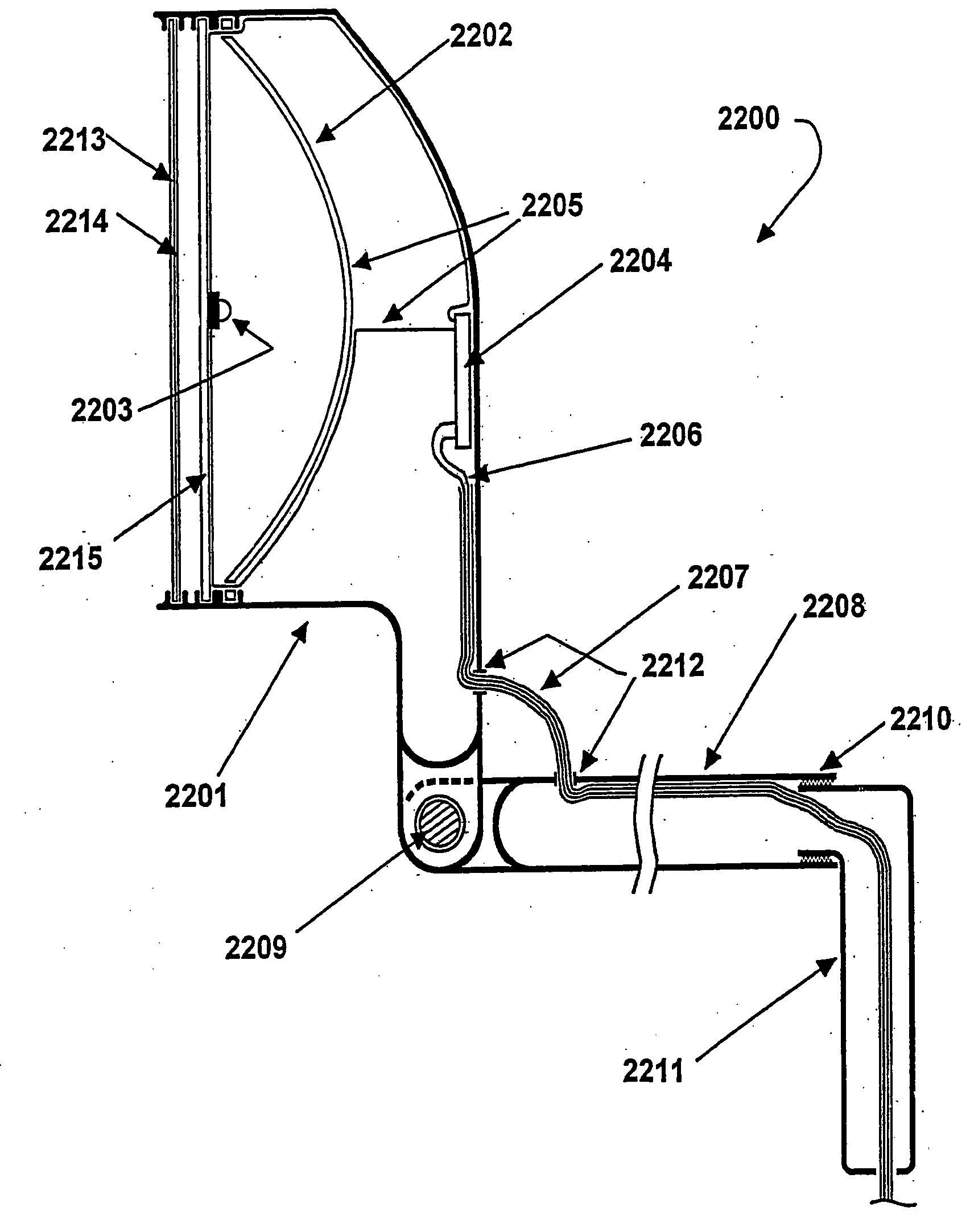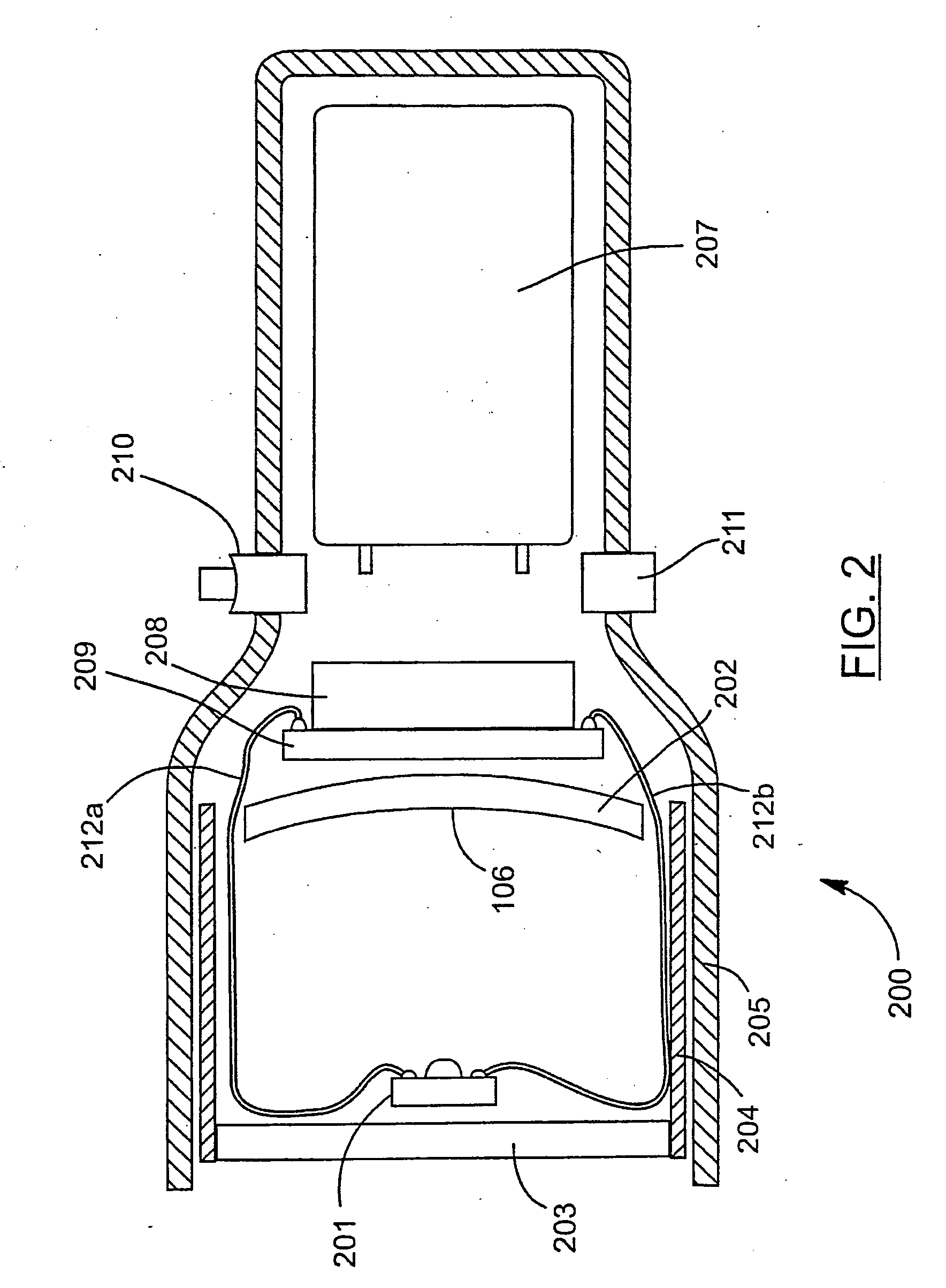LED spotlight
a technology of led spotlights and spotlights, applied in vehicle lighting systems, lighting and heating apparatus, lighting and heating arrangements, etc., can solve the problems of little undesired wavelengths that do not require filters, fluorescent dyes added to some oils and automotive fluids do not respond as well to violet and some near-ultraviolet wavelengths
- Summary
- Abstract
- Description
- Claims
- Application Information
AI Technical Summary
Benefits of technology
Problems solved by technology
Method used
Image
Examples
second embodiment
[0084]Referring to FIG. 2, a second embodiment inspection lamp 200 resembles a flashlight. An LED 201 is provided as a source of radiation that is suitable for causing fluorescence of fluorescent materials. The LED is typically a high power type that typically requires heatsinking. The radiation from the LED may be mainly of wavelengths in a narrow spectral band that peaks in the range of 395 to 415 nanometers, so that the beam produced by the inspection lamp 200 is slightly visible but not so visible as to interfere with viewing of any fluorescent material that the inspection lamp 200 would be used to detect. Longer wavelengths will be found to be better for some purposes, but longer wavelengths would typically necessitate use of a viewing filter or viewing glasses that block at least most of the visible radiation produced by the LED 201. In some applications it would be desirable to use a viewing filter that blocks at least some of the exciting wavelengths even if the exciting rad...
third embodiment
[0094]Referring to FIG. 4, a third embodiment inspection lamp 400 that resembles a flashlight and has lenses 402 to collimate the light from LEDs 401 into beams that merge together into a single beam. The inspection lamp 400 is similar to one described in U.S. Patent Application No. 20020093649, except the curved surfaces 403 of the lenses 401 are not spherical. The text and drawings of U.S. Patent Application No. 20020093649 is hereby incorporated by reference into this detailed description. The curved surfaces 403 may be ellipsoidal. The curved surfaces 403 may have a shape that is a mathematical combination of a paraboloid, an ellipsoid and a sphere. Other aspheric shapes of the curved surfaces 403 of the lenses 402 may be found to be useful. One shape that has been found to be useful is 58% paraboloidal and 42% spherical. This was found suitable if the radius of curvature of the central portions of the curved surfaces is 9.6 millimeters, the overall lens thickness is 4.4 to 5 mi...
fourth embodiment
[0103]Referring to FIG. 5, a fourth embodiment is an inspection lamp 500 that has an LED 501 and a transparent optic 502 that uses reflection or both refraction and reflection to collimate the radiation from the LED 501 into a beam. The transparent optic 502 would typically resemble ones used in the Lumileds “Luxeon with Optics” high power LED light sources, but would typically be larger in order to produce a better beam. The transparent optics used by Lumileds are typically 20 millimeters in diameter, and a transparent optic 502 for the inspection lamp 501 would preferably be 25 to 50 millimeters in diameter.
[0104]Much of the radiation from the LED 501 hits the inner surface 503 of a hollow cylindrical region of the transparent optic 502, and as a result is refracted into a direction that is more perpendicular to the axis of the transparent optic 502. After this refraction, the radiation experiences total internal reflection by the rear surface 504 of the transparent optic 502. The...
PUM
 Login to View More
Login to View More Abstract
Description
Claims
Application Information
 Login to View More
Login to View More - R&D
- Intellectual Property
- Life Sciences
- Materials
- Tech Scout
- Unparalleled Data Quality
- Higher Quality Content
- 60% Fewer Hallucinations
Browse by: Latest US Patents, China's latest patents, Technical Efficacy Thesaurus, Application Domain, Technology Topic, Popular Technical Reports.
© 2025 PatSnap. All rights reserved.Legal|Privacy policy|Modern Slavery Act Transparency Statement|Sitemap|About US| Contact US: help@patsnap.com



